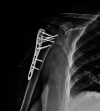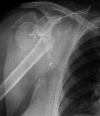Comparison of Treatment Options of Three- and Four-Part Humerus Proximal Fractures in Patients Over 50 Years of Age
- PMID: 34603887
- PMCID: PMC8476210
- DOI: 10.7759/cureus.17516
Comparison of Treatment Options of Three- and Four-Part Humerus Proximal Fractures in Patients Over 50 Years of Age
Abstract
Introduction Our aim was to evaluate different treatment methods including conservative treatment (CT), locking-plate osteosynthesis (OS) and hemiarthroplasty (HA) in three- and four-part humeral fractures in patients older than 50 years. Methods Forty-seven patients that have at least one year of follow-up were divided into three groups: 18 patients treated with OS, 14 patients treated conservatively and 15 patients treated with HA. For further evaluation, constant shoulder score, disabilities of the arm, shoulder and hand score (DASH), American Shoulder and Elbow Society (ASES) score had been used. Shoulder range of motion was also assessed. Results OS and CT groups had better scores than HA group. In OS group, average Constant score was 71.6 ± 16.2, DASH score was 12.1 (5.2-24.2) and ASES score was 77.5 (50.8-96.6). In CT group, average Constant score was 69.6 ± 19.2, DASH score was 16.4 (12.5-36.7) and ASES score was 76.6 (45.4-87.9). DASH scores (p = 0.032), Constant scores (p = 0.001), forward elevation (p < 0.001), abduction (p < 0.001), internal (p = 0.022) and external rotation (p = 0.048) were significantly improved in OS and CT groups than HA group. Conclusions HA should not be considered a priority in surgical planning in Neer three-part and four-part proximal humerus fractures. CT is superior for patients with additional morbidity and advanced age. But in patients who are younger and can tolerate the surgical procedure, the priority should be OS.
Keywords: neer 3- and 4-part fractures; osteosynthesis; proximal humerus fractures; shoulder hemiarthroplasty; upper extremity trauma.
Copyright © 2021, Erpala et al.
Conflict of interest statement
The authors have declared that no competing interests exist.
Figures






Similar articles
-
Comparison of the Effects of Proximal Humeral Internal Locking System (PHILOS) Alone and PHILOS Combined with Fibular Allograft in the Treatment of Neer Three- or Four-part Proximal Humerus Fractures in the Elderly.Orthop Surg. 2019 Dec;11(6):1003-1012. doi: 10.1111/os.12564. Epub 2019 Nov 24. Orthop Surg. 2019. PMID: 31762222 Free PMC article.
-
Operative treatment of 2-part surgical neck fractures of the proximal humerus (AO 11-A3) in the elderly: Cement augmented locking plate Philos™ vs. proximal humerus nail MultiLoc®.BMC Musculoskelet Disord. 2016 Oct 28;17(1):448. doi: 10.1186/s12891-016-1302-6. BMC Musculoskelet Disord. 2016. PMID: 27793135 Free PMC article. Clinical Trial.
-
Plate vs reverse shoulder arthroplasty for proximal humeral fractures: The psychological health influence the choice of device?World J Orthop. 2022 Mar 18;13(3):297-306. doi: 10.5312/wjo.v13.i3.297. eCollection 2022 Mar 18. World J Orthop. 2022. PMID: 35317248 Free PMC article.
-
Is reverse total shoulder arthroplasty more effective than hemiarthroplasty for treating displaced proximal humerus fractures in older adults? A systematic review and meta-analysis.Orthop Traumatol Surg Res. 2018 Oct;104(6):759-766. doi: 10.1016/j.otsr.2018.04.025. Epub 2018 Jun 30. Orthop Traumatol Surg Res. 2018. PMID: 29969722
-
Outcome measures reported for the management of proximal humeral fractures: a systematic review.J Shoulder Elbow Surg. 2020 Oct;29(10):2175-2184. doi: 10.1016/j.jse.2020.04.006. Epub 2020 Jun 9. J Shoulder Elbow Surg. 2020. PMID: 32951643
Cited by
-
Postoperative outcomes of third-generation shoulder hemiarthroplasties for three-and four-part proximal humeral fractures: A systematic review of published studies from 2012 to 2022.J Clin Orthop Trauma. 2024 Jun 7;53:102435. doi: 10.1016/j.jcot.2024.102435. eCollection 2024 Jun. J Clin Orthop Trauma. 2024. PMID: 38983585 Free PMC article. Review.
-
Comparison between arthroplasty and non-operative treatment for proximal humeral fractures: a systematic review and meta-analysis.Front Med (Lausanne). 2024 Sep 6;11:1436000. doi: 10.3389/fmed.2024.1436000. eCollection 2024. Front Med (Lausanne). 2024. PMID: 39309678 Free PMC article.
-
Reverse shoulder arthroplasty vs. hemiarthroplasty for the treatment of osteoporotic proximal humeral fractures in elderly patients: A systematic review and meta‑analysis update.Exp Ther Med. 2022 Aug 24;24(4):637. doi: 10.3892/etm.2022.11574. eCollection 2022 Oct. Exp Ther Med. 2022. PMID: 36160890 Free PMC article.
References
-
- Meta-analysis suggests that reverse shoulder arthroplasty in proximal humerus fractures is a better option than hemiarthroplasty in the elderly. Wang J, Zhu Y, Zhang F, Chen W, Tian Y, Zhang Y. Int Orthop. 2016;40:531–539. - PubMed
-
- Epidemiology of proximal humerus fractures. Launonen AP, Lepola V, Saranko A, Flinkkilä T, Laitinen M, Mattila VM. Arch Osteoporos. 2015;10:2. - PubMed
-
- Evaluation of vitamin D and biochemical parameters in patients operated for hip fracture. Mert M, Ermutlu C. Dicle Med J. 2020;47:446–454.
-
- Osteoporosis risk factors in the women over 45-years old. Pınar G, Pınar T, Doğan N, Karahan A, Algıer L, Abbasoğlu A, Kuşçu E. https://dergipark.org.tr/tr/download/article-file/53986 Dicle Med J. 2009;36:258–266.
LinkOut - more resources
Full Text Sources
